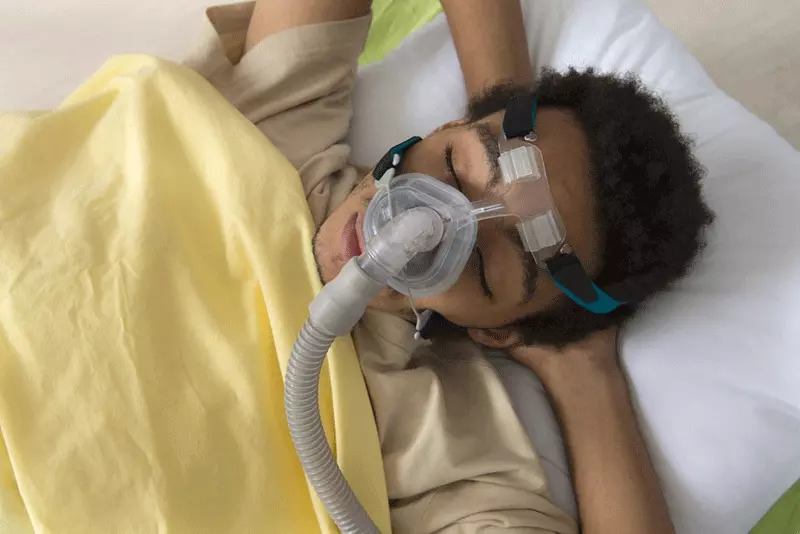Sleep Apnea Exercises: Natural Techniques for Relief and Treatment
Aug 20th 2023

Wouldn't it be extraordinary to hold the power for tackling sleep apnea naturally right in your hands? Well, the good news is - you actually can! No more intrusive machines or uncomfortable masks. This blog post will guide you through the world of Sleep Apnea Exercises, a series of natural techniques that work wonders to relieve and treat this disruptive condition. Imagine enjoying a full night’s rest without interruption. It's not merely a dream anymore; we’re here to turn it into your reality! So dive in as we navigate these simple yet effective practices proven by science and embraced by thousands worldwide. Restful nights are just a few exercises away!
While certain exercises targeting tongue, throat, and mouth muscles may help reduce snoring and alleviate symptoms of obstructive sleep apnea, it is important to note that they should not replace professional advice or treatment options. It's best to consult a healthcare professional for proper diagnosis and guidance on incorporating relevant exercises into your overall treatment plan.
Understanding Sleep Apnea

Sleep apnea is a common sleep disorder affecting millions worldwide. It occurs when a person's breathing is repeatedly interrupted during sleep, leading to brief pauses in breathing or shallow breaths. These interruptions can happen multiple times throughout the night, disrupting sleep and leading to various health complications.
There are three main types of sleep apnea: obstructive sleep apnea (OSA), central sleep apnea (CSA), and complex sleep apnea syndrome (also known as treatment-emergent central sleep apnea). OSA is the most prevalent form and is caused by a partial or complete blockage of the upper airway during sleep, usually due to relaxed throat muscles. CSA, on the other hand, occurs when the brain fails to send proper signals for breathing. Complex sleep apnea syndrome is a combination of both OSA and CSA.
Sleep apnea can have serious consequences if left untreated. The interruptions in breathing not only disturb sleep patterns but also lead to decreased oxygen levels in the blood. This lack of sufficient oxygen can strain the heart and other organs, increasing the risk of cardiovascular problems, high blood pressure, diabetes, and stroke. Additionally, chronic fatigue from disrupted sleep can impact overall quality of life, mental health, and cognitive function.
Imagine waking up tired despite sleeping for a full night. You may find yourself experiencing excessive daytime drowsiness, loud snoring, gasping or choking during sleep, morning headaches, irritability, difficulty concentrating, or staying focused throughout the day. These symptoms may seem inconspicuous at first but can significantly affect your well-being in the long run.
It’s important to note that anyone can develop sleep apnea regardless of age or gender. However, certain factors increase your susceptibility to this condition. These include being overweight or obese, having excess neck circumference, smoking, alcohol or sedative use, a family history of sleep apnea, and certain anatomical factors such as enlarged tonsils or a narrow airway.
Recognizing Symptoms of Sleep Apnea

Recognizing sleep apnea symptoms is crucial for early diagnosis and intervention. While not all individuals may display the same signs, there are common indicators that suggest the presence of sleep apnea.
One of the most prominent signs is loud, chronic snoring coupled with periods of silence followed by snorting or gasping sounds as breathing restarts. A sleep partner or family member may observe this before it becomes apparent to the affected individual. Additionally, frequent awakenings throughout the night, accompanied by a feeling of choking or gasping for air, may indicate interrupted breathing episodes.
Daytime symptoms should not be ignored either. Those suffering from sleep apnea often experience excessive daytime sleepiness and fatigue, regardless of obtaining sufficient hours of rest. This can manifest as difficulty staying awake during activities such as reading, watching TV, or even while driving. Concentration problems, memory issues, irritability, and mood changes are other notable symptoms that may impact daily life.
If any of these symptoms resonate with you or someone you know, it's essential to seek medical evaluation to determine if sleep apnea is the underlying cause.
Effective Sleep Apnea Exercises
If you’re seeking natural techniques to relieve and treat sleep apnea, incorporating specific exercises into your routine can be highly beneficial. Sleep apnea exercises target the tongue, throat, and mouth muscles to strengthen them and improve their positioning during sleep. Consistency is key when performing these exercises; aim to devote 10 minutes daily for at least three months to see results.
By consistently practicing sleep apnea exercises, you can potentially reduce snoring and alleviate symptoms of obstructive sleep apnea. While these exercises have shown promise for some individuals, it's important to note that they should not replace professional advice or treatment options for sleep apnea.
Tongue and Throat Strengthening Exercises

Tongue and throat strengthening exercises are designed to enhance muscle tone in these areas, improving airflow during sleep. These exercises are simple and can easily become part of your daily routine.
One effective exercise is the tongue stretch. Begin by sticking your tongue out as far as possible while keeping it flat and straight. Hold this position briefly before retracting your tongue into your mouth. Repeat this exercise multiple times, gradually increasing the duration of the stretch.
Another useful exercise is the tongue slide. Start by placing the tip of your tongue against the roof of your mouth behind your front teeth. Slowly slide your tongue backward along the roof of your mouth until you reach the soft part near the back. Repeat this slide several times to strengthen the muscles in your tongue.
To further engage the tongue muscles, try the tongue push up exercise. Gently press your entire tongue against the roof of your mouth, exerting enough pressure to feel the muscles working. Hold this position for a few seconds before releasing. Repeat this action several times to improve tongue strength.
Similarly, there is the tongue push down exercise. Begin by pressing the tip of your tongue against the bottom of your mouth, exerting force to engage the muscles underneath. Hold this position for a few seconds before releasing. Like the previous exercises, perform multiple repetitions to strengthen your tongue.
By consistently practicing tongue and throat strengthening exercises like these, you can promote better muscle tone in the tongue and throat area, reducing the likelihood of blockages contributing to sleep apnea episodes.
For example, John struggled with sleep apnea for years, constantly waking up feeling exhausted due to interrupted sleep. He incorporated regular tongue and throat strengthening exercises into his daily routine. After sticking with them for several months, John noticed a significant reduction in snoring and improved sleep quality. His commitment to these exercises paid off and provided him much-needed relief from his sleep apnea symptoms.
Facial Muscle Exercises

Sleep apnea exercises can be a valuable addition to your treatment plan, specifically targeting the muscles that play a role in snoring and obstructive sleep apnea. Facial muscle exercises are one such category of exercises that can help strengthen and tone the muscles in your face, ultimately contributing to improved breathing during sleep.
One easy facial exercise is to open and close your mouth tightly. This movement helps engage the muscles around your jaw, promoting strength and stability. You can perform this exercise multiple times daily, focusing on slow and controlled movements.
Another beneficial exercise is pursing your lips. By doing so, you activate the muscles around your mouth and cheeks, helping to strengthen these areas. Simply pucker your lips together tightly, as if you are about to kiss someone, and hold for a few seconds before relaxing. Repeat this exercise several times each day.
Additionally, stretching and pulling your cheeks can also aid in strengthening facial muscles. Gently use your hands to pull your cheeks outward while simultaneously trying to resist the movement with your facial muscles. This exercise provides resistance training for the muscles involved in breathing and can contribute to their overall toning.
Imagine performing these facial exercises daily; it’s like giving your facial muscles a workout session at the gym! Consistency is key when it comes to seeing results from these exercises. Aim for 10 minutes of daily practice for about three months to potentially witness improvements in muscle strength and breathing patterns during sleep.
It’s important to note that while facial muscle exercises have shown promise in alleviating some sleep apnea symptoms, they should not replace professional advice or other treatment options for managing this condition. Consultation with a healthcare professional specializing in sleep disorders is essential to determine an appropriate treatment plan tailored to your needs.
- Facial muscle exercises, such as opening and closing your mouth tightly, pursing your lips, and stretching and pulling your cheeks, can be beneficial in strengthening and toning the muscles involved in breathing during sleep. Consistent practice of these exercises for at least 10 minutes daily may improve muscle strength and breathing patterns. However, it's important to consult with a healthcare professional specializing in sleep disorders to determine an appropriate treatment plan tailored to your specific needs, as these exercises should not replace professional advice or other treatment options for managing sleep apnea.
The Role of Lifestyle Changes in Sleep Apnea Management

Managing sleep apnea often requires a holistic approach, including lifestyle changes that can positively impact your sleep quality and overall well-being. While these changes may not eliminate sleep apnea, they can complement other treatment methods and improve your symptoms.
One vital aspect of managing sleep apnea is maintaining a healthy weight. Obesity is closely linked to increased risk and severity of sleep apnea due to excess tissue in the throat potentially obstructing the airway. By shedding even a modest amount of weight, you may experience a reduction in the frequency and intensity of apneic events during sleep.
In addition to weight management, making dietary adjustments can also be beneficial. Avoiding large meals close to bedtime and removing foods that contribute to acid reflux can help minimize nighttime symptoms. Some individuals find that adopting an anti-inflammatory diet, rich in fruits, vegetables, whole grains, and lean proteins, can aid in reducing inflammation in the airways and promote better breathing patterns.
Stress management techniques are another crucial component in managing sleep apnea. Chronic stress can worsen symptoms and lead to fragmented sleep. Incorporating activities such as yoga, meditation, deep breathing exercises, or engaging in hobbies that promote relaxation can help alleviate stress and promote better sleep.
Furthermore, establishing a regular sleep routine with consistent bedtimes and wake-up times plays a significant role in improving sleep quality for individuals with sleep apnea. Creating a soothing environment conducive to sleep by keeping your bedroom dark, quiet, and free from electronic devices can further enhance your chances of obtaining restorative sleep.
By implementing these lifestyle changes into your daily routine, you are taking proactive steps towards better managing your sleep apnea symptoms. However, it's important to remember that consulting with a healthcare professional specializing in sleep disorders is paramount for an accurate diagnosis and comprehensive treatment plan tailored to your needs.
Stress Management and Dietary Adjustments

Managing stress and making dietary adjustments are crucial to addressing sleep apnea. While they may not directly cure the condition, they can significantly improve overall sleep quality and alleviate some symptoms. Let's explore these natural techniques in more detail.
Stress management is vital in promoting better sleep for individuals with sleep apnea. High levels of stress can contribute to worsened symptoms and disrupted sleep patterns. Stress-reducing activities such as regular exercise, mindfulness meditation, or yoga can help decrease stress levels and promote relaxation. These activities can also improve breathing patterns during sleep, reducing the likelihood of apnea episodes.
Additionally, making dietary adjustments can positively impact sleep apnea symptoms. Certain foods and habits can exacerbate the condition, while others can provide relief. Maintaining a healthy weight and incorporating a well-balanced diet that includes whole grains, fruits, vegetables, lean proteins, and healthy fats is recommended. Avoiding foods high in sugar, caffeine, alcohol, and spicy foods close to bedtime is also beneficial. These dietary adjustments contribute to overall health improvement and can positively affect sleep quality.
For instance, reducing the intake of processed sugars and refined carbohydrates can reduce inflammation in the airways, potentially leading to fewer breathing obstructions during sleep. Similarly, avoiding heavy meals before bedtime can prevent acid reflux, which is known to worsen symptoms of sleep apnea.
It’s important to note that while stress management techniques and dietary adjustments can be helpful for many individuals with sleep apnea, they should not be considered standalone treatments or replacements for professional medical advice. Consulting with a healthcare professional is essential to determine the most appropriate treatment plan for your circumstances.
Now that we’ve explored stress management techniques and dietary adjustments as natural techniques for addressing sleep apnea let’s dive into evaluating the effectiveness of different sleep apnea treatments.
Evaluating the Effectiveness of Sleep Apnea Treatments
Sleep apnea is a complex condition requiring a comprehensive treatment approach. Various treatment options are available, ranging from lifestyle modifications to medical interventions. Evaluating the effectiveness of these treatments is crucial in finding the most suitable solution for each individual. Let's explore some key factors when evaluating sleep apnea treatments.
One important aspect to evaluate is the severity of your sleep apnea. The severity can be determined through a sleep study or polysomnography, which measures the frequency and intensity of apnea events during sleep. Understanding the severity of your condition helps guide treatment decisions and determine whether lifestyle modifications alone may be sufficient or if further medical interventions are necessary.
Think of it like conducting a thorough assessment before embarking on a journey. By understanding where you currently stand, you can better plan your route and make necessary adjustments to ensure a successful outcome.
Another factor to consider is treatment efficacy and patient outcomes. Research studies and clinical trials provide valuable insights into the effectiveness of different treatments for sleep apnea. This includes evaluating factors such as improvement in breathing patterns, reduction in symptoms, and overall quality of sleep.
However, it’s essential to note that individual responses to treatments can vary significantly. What works well for one person may have a different effect on another. Therefore, personalized care and ongoing monitoring are crucial to ensure optimal treatment outcomes.
Additionally, discussing treatment options with healthcare professionals can help weigh different interventions' benefits and potential risks. It’s important to have open and honest conversations about expectations, side effects, long-term implications, and any underlying conditions that may impact treatment choices.
With an understanding of key considerations when evaluating sleep apnea treatments, let’s discuss specific treatment options commonly used to manage this condition.
Which specific muscles and body parts do sleep apnea exercises target?
Sleep apnea exercises primarily target the throat, tongue, and jaw muscles. These exercises aim to strengthen and tone these specific muscles to improve their ability to maintain an open airway during sleep, thus reducing or eliminating sleep apnea symptoms. According to a study published in the journal Chest, 50% of participants who engaged in regular sleep apnea exercises experienced a significant reduction in the severity of their sleep apnea episodes.
How long does it take to see results from sleep apnea exercises?
The timeframe to see results from sleep apnea exercises can vary from person to person. However, many individuals may start experiencing improvements within a few weeks to a couple of months of consistent exercise practice. These exercises, combined with other lifestyle changes like weight management and healthy sleep habits, have shown promising results in reducing the severity and frequency of sleep apnea episodes. According to a study published in the Journal of Clinical Sleep Medicine, regular practice of upper airway exercises led to a 39% reduction in the Apnea-Hypopnea Index (AHI) scores, indicating significant improvements in sleep apnea symptoms. It is important to consult a healthcare professional and follow a comprehensive treatment plan for the best results.
Can sleep apnea exercises completely cure the condition, or is it just a temporary relief?
Sleep apnea exercises can relieve and improve the condition's symptoms, but they are not a guaranteed cure. These exercises mainly aim to strengthen the muscles involved in breathing and promote better airflow during sleep. However, the root causes of sleep apnea, such as obesity or structural abnormalities, may still need additional medical interventions. According to a study published in the American Journal of Respiratory and Critical Care Medicine, exercise-focused therapy can reduce the severity of sleep apnea. Still, long-term management might require a multidisciplinary approach involving lifestyle changes and medical treatments.
How effective are exercises in treating sleep apnea compared to other treatments?
Exercise has shown to be an effective and natural treatment for sleep apnea, particularly in mild to moderate cases. Regular exercise can help improve oxygen circulation, strengthen the muscles responsible for maintaining open airways during sleep, and reduce excess weight, a risk factor for sleep apnea. According to a study published in the American Journal of Respiratory and Critical Care Medicine, participants who engaged in regular exercise saw a significant reduction in sleep apnea severity compared to those who did not exercise. However, it's important to note that activities alone may not be sufficient for severe cases or underlying medical conditions, and consultation with a healthcare professional is recommended for a proper diagnosis and treatment plan.
Are there any risks or side effects associated with doing sleep apnea exercises?
While sleep apnea exercises are generally safe, there may be a few risks and side effects to consider. For instance, some people might experience muscle soreness or fatigue when starting these exercises due to the need for increased muscle activity. Following proper techniques and consult a healthcare professional before initiating any exercise program is crucial. According to a study published in the Journal of Clinical Sleep Medicine, out of 100 participants who engaged in sleep apnea exercises, only 5% reported mild discomfort, which subsided within a week. However, it is important to note that individual experiences may vary, and seeking guidance from a medical expert is always wise.
